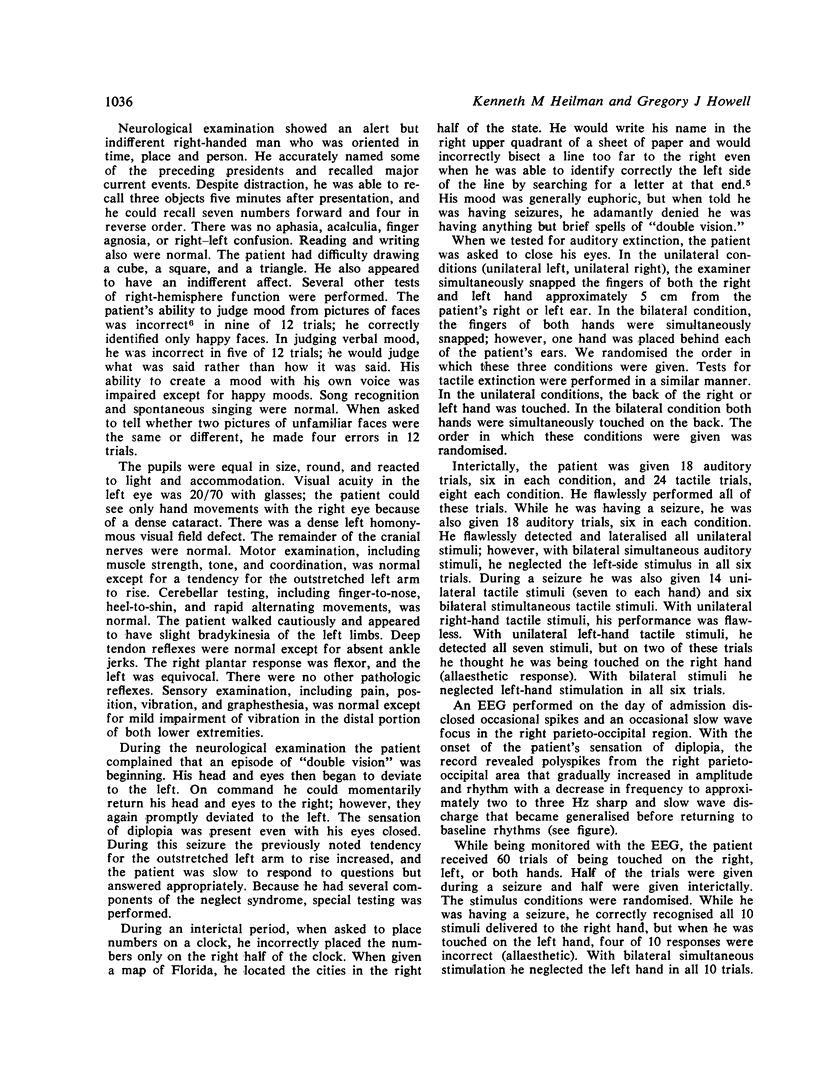Abstract
A man with intermittent right parieto-occipital seizures was monitored by electroencephalography while he received 60 trials of being touched on the right, left, or both hands. Half of the trials were given during a focal seizure, and half were given interictally. While the patient was having seizures, he appropriately responded to all 10 stimuli delivered to the right hand, but four of 10 responses were incorrect (allaesthetic) when he was stimulated on the left. With bilateral simultaneous stimulation he neglected the left hand in all 10 trials. His interictal performance was flawless. When given a line-bisection task on two occasions during a seizure, the patient attempted to make a mark to the left of the entire sheet of paper. Immediately postictally he made a mark at the right end of the line. The case illustrates that focal seizures may induce elements of the neglect syndrome and that attention (to contralateral stimuli) and intention to perform (in the contralateral hemispatial field) may be dissociable phenomena.
Full text
PDF





Selected References
These references are in PubMed. This may not be the complete list of references from this article.
- Anzola G. P., Bertoloni G., Buchtel H. A., Rizzolatti G. Spatial compatibility and anatomical factors in simple and choice reaction time. Neuropsychologia. 1977;15(2):295–302. doi: 10.1016/0028-3932(77)90038-0. [DOI] [PubMed] [Google Scholar]
- Berlucchi G., Heron W., Hyman R., Rizzolatti G., Umiltà C. Simple reaction times of ipsilateral and contralateral hand to lateralized visual stimuli. Brain. 1971;94(3):419–430. doi: 10.1093/brain/94.3.419. [DOI] [PubMed] [Google Scholar]
- Heilman K. M., Watson R. T. Mechanisms underlying the unilateral neglect syndrome. Adv Neurol. 1977;18:93–106. [PubMed] [Google Scholar]
- Lynch J. C., Mountcastle V. B., Talbot W. H., Yin T. C. Parietal lobe mechanisms for directed visual attention. J Neurophysiol. 1977 Mar;40(2):362–389. doi: 10.1152/jn.1977.40.2.362. [DOI] [PubMed] [Google Scholar]
- Pandya D. N., Kuypers H. G. Cortico-cortical connections in the rhesus monkey. Brain Res. 1969 Mar;13(1):13–36. doi: 10.1016/0006-8993(69)90141-3. [DOI] [PubMed] [Google Scholar]
- Pribram K. H., McGuinness D. Arousal, activation, and effort in the control of attention. Psychol Rev. 1975 Mar;82(2):116–149. doi: 10.1037/h0076780. [DOI] [PubMed] [Google Scholar]
- Robinson D. L., Goldberg M. E., Stanton G. B. Parietal association cortex in the primate: sensory mechanisms and behavioral modulations. J Neurophysiol. 1978 Jul;41(4):910–932. doi: 10.1152/jn.1978.41.4.910. [DOI] [PubMed] [Google Scholar]
- Watson R. T., Miller B. D., Heilman K. M. Nonsensory neglect. Ann Neurol. 1978 Jun;3(6):505–508. doi: 10.1002/ana.410030609. [DOI] [PubMed] [Google Scholar]
- Yin T. C., Mountcastle V. B. Visual input to the visuomotor mechanisms of the monkey's parietal lobe. Science. 1977 Sep 30;197(4311):1381–1383. doi: 10.1126/science.408924. [DOI] [PubMed] [Google Scholar]


